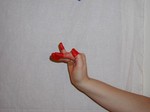Recita
Nṛttahastas - Dance hands (single and combined)
Descriptions and Meanings
9:185
Recita. Two Hamsapaksa hands moving swiftly with the palms facing upward is called Recita. This is like the ordinary Recita of the hands.
9:181
Recita—the two Haṃsapakṣa hands swiftly moving with the palms facing upward. This is like the ordinary Recita [of the hands].
26:77
Whpn the Haṁsa-paksa hands move upwards and the palms are also spread upwards, they are called Recita.
No verse annotation
Recita: Hamsa-paksa hands face upwards, held apart. Patron deity Yaksaraja.
No verse annotation:
holding children, showing a painted panel (citra-phalaka).

Haṁsapaksha - No verse annotation

Haṁsapaksha - No verse annotation
Mentioned by:
Ardharecita
8:512-513
When the palms of two Hamsapaksha hastas face upwards and held high, it is Rēcita hasta.
8:512-513:
This hasta denotes holding children and showing a painted panel and such other aspects.
8:576-577
When two Alapadma hastas are jointly extended on the sides, then it is Recita hasta.
8:576-577:
This hasta is used to denote the following: Carinatana, Parswanatana, coconut tree, chattering ; it is also used at appropriate times in all the dances.
4:1248-1249
Recita: The hands which are in the Haṁsapakṣa Hasta are extended away from the sides and quickly moved in a circular manner.
7:85
Recita : If the hands are spread and lifted upwards and moved fast it is recita.
2:250
The haṁsapakṣa hastas are turned supine (the palm facing upwards), hands stretched forward and moved randomly with speed. These are the recita hastas
2:250:
it is used to show Narasimha opening the enemy’s chest.
:869
If the two Hamsapaksas are brought from the lap quickly to the two sides and then brought back and this is repeated, it is Recita
7:115
If in this (same) patākas or haṁsapakṣas move rapidly, it is recita.
3:491
The hands stretched out with palms raised is known as recita. Some say that haṁsapaksha hands moved in a circle and held still is recita.
3:491:
This is used in tearing up the chest of the demon by Nrsimha.



